Beach camping in the Ten Thousand Islands is one of our favorite kayak outings, but it’s not an easy adventure and requires careful preparation.
When paddling a kayak, canoe or SUP through these islands, consider this:
- These are largely mangrove islands, and they all look the same, making it easy to get lost in a confusing landscape. You won’t be the first (or the last) to paddle in circles for hours. Make note of landmarks when you can.
- Tides change quickly, and these are shallow waters, creating cross currents that seem to defy tidal flow, further throwing off your sense of direction.
- The weather is unpredictable. Even on nice days, I’ve seen storms pop up out of nowhere and whip up a fury with little notice.
Once while traversing Chokoloskee Bay on our return to the Everglades National Park Visitor Center in Everglades City, we encountered howling winds and white-cap surf so severe that rangers, watching from their observation tower, didn’t think we would make it.
There were moments we didn’t think we would, either.
Before you go…
- Check tide tables for Everglades City. For best results, leave on the outgoing tide and return on an incoming tide.
- Know the weather forecast and check it often. High winds mean rough seas and counter-intuitive tidal currents.
- Be prepared. This is not a casual paddle.
Perfect Weather for Beach Camping
The forecast couldn’t have been better – sunny skies with highs in the mid 70s and lows in the high 50s, winds 5 to 10 mph, at the end of a two-week cold snap that should knock down the mosquitoes.
I trailered my 19-foot Cobia center console to Everglades City with two kayaks on board. The motorboat would transport gear while my wife Kathy paddled with our friend Warren Richey out through Indian Key Pass (5-6 miles) to the Gulf, and then three miles north to Panther Key.
Launching kayaks at the Everglades National Park Ranger Station in Everglades City was easy, and a backcountry camping permit was not needed because our destination was Panther Key in Ten Thousand Islands National Wildlife Refuge, north of the national park boundary.
Even though we were camping outside Everglades National Park, we had to leave our cars there, so we left a float plan with park rangers, identifying our parked vehicles, our planned route, date of return and where we planned to camp.
While there is a kayak launch at the ranger station, the park does not have a boat ramp. We launched from a private ramp across the street. Another private boat ramp is available in nearby Chokoluskee. (Fees are likely.)
Follow channel markers. The waters here are shallow and shoals are frequent.
Time your departure to the outgoing tide
Timing is everything for paddlers. Check the tides before you go. You should plan to leave Everglades City at high tide or shortly after so the current is with you as you paddle or power to the outer islands.
Plan your return on the reverse: Low tide on the outside so you return on the incoming tidal current.
If you plan to paddle between islands, outside of the main channels, be prepared to encounter unpredictable tidal cross currents. Blindly following currents is how people get lost, so carry a GPS.
Kathy and Warren had a ball riding the outgoing tide, staying outside of the channel, which can get busy on weekends with tour boats, anglers and pleasure boaters. Dolphin were everywhere, playful with the kayakers as they paddled out Indian Key Pass.
I motored ahead and waited until they arrived at Indian Key on the Gulf.
The channel is deep, well-marked and well-maintained, so there’s little chance of running aground unless you veer far outside the channel into unmarked bays and trails that are ubiquitous in these islands. A nautical chart, GPS, and local knowledge are tools all boaters want to employ.
From Indian Key, at the mouth of the pass, I threw a line to Kathy to tow her 9.5-foot kayak the final 3-4 miles over open water to Panther Key. Warren, no stranger to open water in his 17.5-foot sea kayak, paddled on ahead.
My kayak, a 12-foot sit-on-top, rode comfortably on the deck of my motorboat, although I learned a great deal about packing gear on the deck when I had to scramble around it to get to anchors, dock lines and unhook the straps on my Bimini top.
Navigating to Panther Key from the outside offered a few surprises, largely due to the changing landscape caused by recent hurricanes.
An important landmark, Round Key, was whacked to half its former size, and the seaward point on Panther Key was totally wiped out, leaving a near-naked shoal.
Shoals and coral outcroppings are common in the islands, so motor vessels should have a reliable depth sounder on board. While charts are useful, there is no way to anticipate what the weather has wrought since the chart was published.
On our way to Panther Key, we passed two islands within the National Park where camping is permitted, Picnic Key and Tiger Key. Both require a backcountry camping permit, which can be obtained at the
Everglades National Park Visitor Center. Backcountry permits are issued in person up to 24 hours in advance.
Ten Thousand Islands Wildlife Refuge
Once past Tiger Key, you are leaving Everglades National Park and entering the Ten Thousand Islands National Wildlife Refuge, which does not require back-country permits for camping.
Camp Lulu and Panther Key are wide open for camping, and there are no fees. We considered Lulu, which is just past Tiger Key, but chose to continue on to Panther because we expected Lulu to be too crowded for our tastes on a beautiful New Years Weekend.
Camp Lulu has long been the party island.
Swinging wide around Round Key, Panther Key is straight ahead. The point of the island is a mass of tangled driftwood, dead trees and mangrove trunks ripped out and stacked haphazardly, if not artistically, from batterings by hurricanes.
As you approach Panther, you will see a marker that identifies the channel going to Port of the Islands through Faka Union Bay. This is your access point to the beaches on the south side of Panther. We decided to swing wide around the point and camp on the north side.
Once around the point, the bay between Panther and Hog Key, also a popular camping destination, is quite deep, and I was able to bring my motorboat right up to the beach and anchor there for the weekend.
Alternate routes to Panther Key
Goodland on Marco Island
Goodland is a rustic little fishing village on Marco Island. Launch your boats from the ramp at the Calusa Island Marina. There is a well-marked channel from Goodland through Coon Key Pass to the Gulf, then follow the outer islands to Panther Key.
Navigation note: If you are in a motorboat, be aware \these islands are surrounded by broad, shallow flats with prolific coral outcroppings. Stay well offshore until you reach Panther Key, then navigate cautiously. I lost a propeller here once on coral. Fortunately, I brought a spare propeller.
Port of the Islands
There is a boat ramp at the Port of the Islands Marina, which also offers kayak rentals. There is also a moderately priced resort for those who want to go kayaking in the refuge but not camp.
From the marina, follow the Faka Union Canal. The well-marked Faka Union River channel will take you straight to the south side of Panther Key.
Beach Camping on Panther Key
We pitched camp on the north side of Panther for shelter from the southeast winds (actually a breeze, but it can change fast). The risk, of course, is that the leeward side of the island is heaven for mosquitoes, but we expected the mosquitoes had probably been knocked down pretty good by a December chill.
Camping is allowed only on the outer barrier islands of the Refuge from October until April. Camping is not allowed May to September due to nesting shorebirds and sea turtles. Camping does not require a permit or reservations, free spaces are available on a first come/first serve basis.
Our friend Warren Richie camps in a jungle hammock, which he finds extremely comfortable and packs easily in his kayak. He was totally self-contained, and he carried a lot of gear in that little boat, a lesson he fine-tuned when he participated in the Ultimate Florida Challenge, a monthlong race that circumnavigates the Florida peninsula.
Kathy and I set up our tent on the beach. There are no outhouses, so we brought a portable potty. For those who wish to rough it, bring a shovel for visits to the woods, but you will need to pack out your used toilet tissue (wildlife refuge regulations).
Warren got right to work gathering wood for the campfire. Even though this is a popular camping area, we found plenty of dead wood on the island.
Once we set up camp, Kathy, a diehard beachcomber, set out along the beach to find shells and weathered driftwood. As darkness approached, we prepared dinner.
Kathy and I brought cold food – cold cuts, bread, fruit, vegetables and snacks – while Warren brought freeze-dried backpacker meals. He brought a backpacker stove to heat water.
The next day, we were off to explore Panther Key and Hog Key in our kayaks, and Warren went fishing while Kathy and I motored up the Fakahatchee Pass to the Faka Union River to explore more back country and an alternative route from Port of the Islands.
On the third morning on yet another beautiful day, we packed our gear for the return to Everglades City.
Camping Gear
- Kayak Camping Checklist — Kayak guru and author Warren Richey shares his checklist of essential gear to pack for the confined space of a kayak. Your needs may vary, as will the size of your boat, but this is a terrific guide to get you started. Read more: Sharkchow’s Kayak Camping Checklist
- Boat Camping Checklist — The author of this article, longtime camper and outdoor enthusiast Bob Rountree, shares his checklist for camping from a larger boat, a 19-foot Cobia. While individual needs will vary, as will the size and features on your boat, this checklist is a good starting point. Read more: Bob’s Boat Camping Checklist
The Return to Everglades City
We left in the morning, just after low tide at Panther. The key for paddlers is to get back to Indian Key Pass so you can ride the tide back down the Barron River to Everglades City and Chokoluskee Island.
Currents are quite swift through the Barron River channel, almost whitewater, so it’s a real thrill for kayakers who can use minimal effort for maximum fun on a five-mile ride back to port.
Chokoloskee Bay was like glass, so the crossing was beautiful for the kayakers. It’s not always that way, as we have learned over many years, and paddlers should always be prepared for stiff headwinds on the open bay.
We arrived at Everglades City at 12:30 p.m., perfect timing for our ritual lunch in Everglades City before returning to Fort Lauderdale across Alligator Alley.
Tiger Key — Everglades National Park
Tiger Key, the northernmost Gulf island within the boundaries of Everglades National Park, is probably my all-time favorite destination for camping in the Ten Thousand Islands. We’ve camped out there perhaps a half-dozen times.
The campsites are on the lee side of the island on a crescent beach just off West Pass. Camp Lulu Key, the “party island,” is on the other side of the pass, just outside Everglades National Park but within the boundary of the wildlife refuge.
There’s a long sandbar that emerges from the pass at low tide where you can fish or just hang out in a beach chair. An absolutely gorgeous setting.
When tides are high, fishing boats ply the waters of the pass, stopping first in the cove off our crescent beach to net bait, then deeper into the islands to fish. Red fish, snook and sea bass are abundant in these waters.
With a kayak, you can explore shallower waters nearby where the redfish and shore birds feed on and around the oyster beds. The mangrove islands are also breeding grounds for shrimp, a variety of gamefish and stone crabs.
Late one night, a diesel-powered trawler entered West Pass around 2 a.m. We didn’t think much of it until the next morning when the marine patrol landed our beach, asking if we had hear any boats passing in the night.
The Ten Thousand Islands are notorious for illegal fishing and smugglers.
Immediately south of Tiger Key is Picnic Key, which has a vault toilet accessible to campers on both islands.
The Picnic Key beach campsites are on the Gulf side, offering no shelter when storms pop up and blow ashore — and blow ashore they do! Mightily. We’ve lost a few tents in those storms.
Backcountry permits required
Camping on either Tiger Key or Picnic Key require backcountry camping permits, which you obtain before setting out from a self-service kiosk at the national park’s Gulf Coast Visitor Center in Everglades City.
There are no reservations, but you can secure a permit 24 hours in advance for the island where you want to camp. A permit processing fee of $15 will be charged as well as a $2 per person per day camping fee. Fees are waived mid-April through mid-November, but permits are still required. (You really don’t want to camp out there in summer.)
If you plan to camp over a weekend during winter, it would be wise to obtain your permit a day 24 hours before your departure. Both Tiger Key and Picnic Key limit the number of campers. Maximum stay is 14 days.
Ten Thousand Islands kayak rentals
- Everglades Adventures Kayak and Eco Tours. Rentals are available November-April only. Ivey House, 605 Buckner Ave North, Everglades City, FL 34139. Phone: (239) 695-4666
- Glades Haven Marina, across from Everglades National Park Gulf Visitor Center, 801 S Copeland Ave, Everglades City, FL 34139. Phone: (239) 293-7743
- Chokoloskee Island Park and Marina. 1150 Hamilton Lane, Chokoloskee, FL 34138. Phone: (239) 695-2414
- Port of the Islands Marina, 525 Newport Dr, Naples, FL 34114. Phone: 239.642.3133
- Calusa Island Marina, 385 Angler Dr, Goodland, FL 34140. Phone: (239) 394-3668
Places to eat in Everglades City
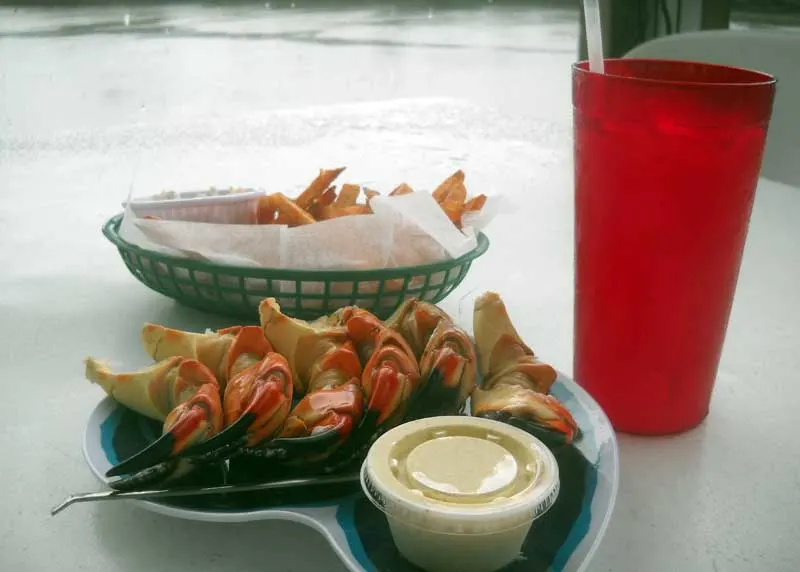
There are many cool places to eat in Everglades City and nearby Chokoloskee Island, but our favorite is the The Triad Seafood Café on the Barron River, just east of the landmark Rod and Gun Club on Camille Street.
Related Stories
- 10,000 Islands: Ride the tide to Indian Key
- A tamer paddle from Everglades City
- Historic Smallwood Store in Chokoloskee
- Eating stone crabs in Everglades City

Bob Rountree is a beach bum, angler and camper who has explored Florida for decades. No adventure is complete without a scenic paddle trail or unpaved road to nowhere. Bob co-founded FloridaRambler.com with fellow journalist Bonnie Gross 14 years ago.


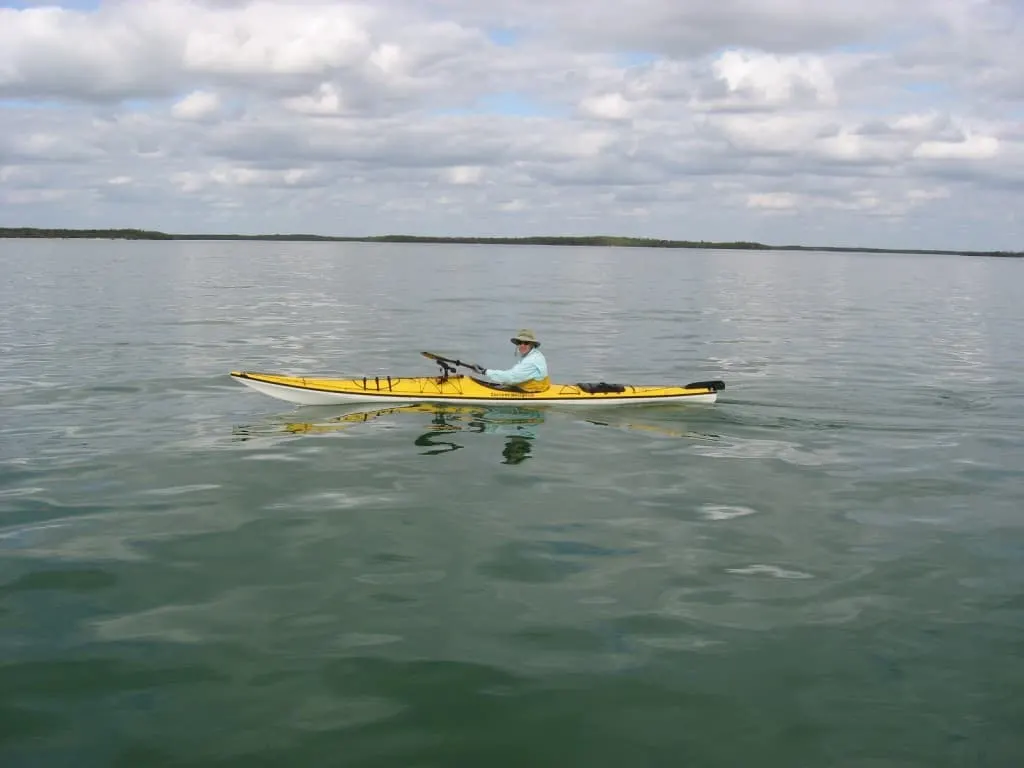
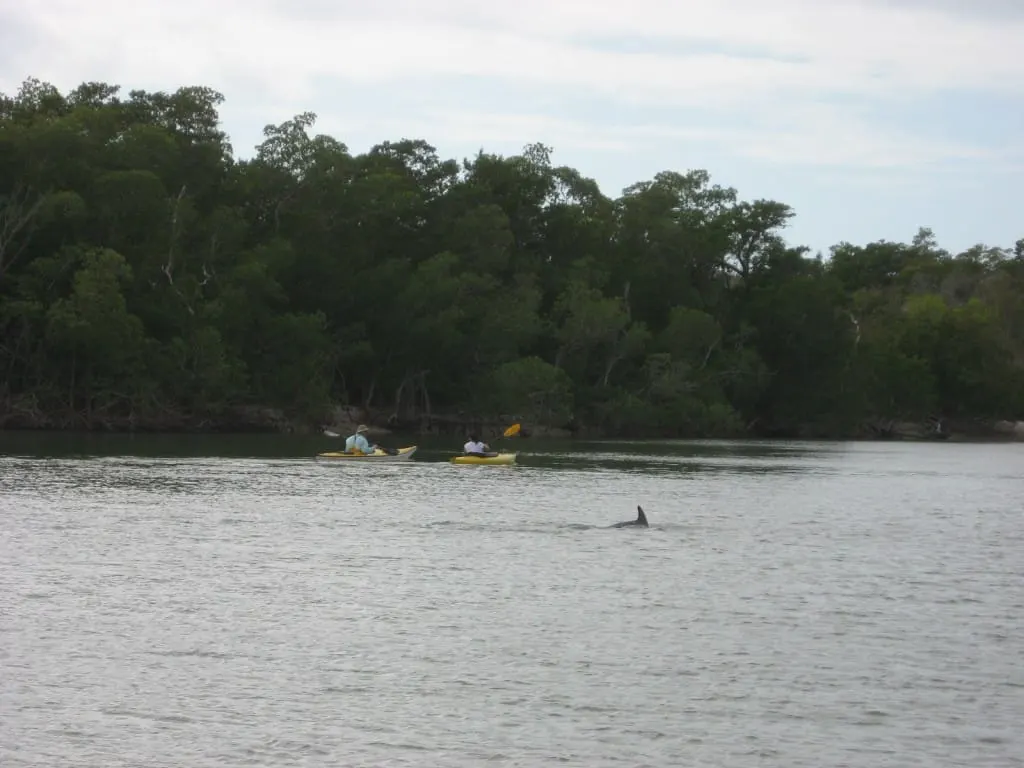
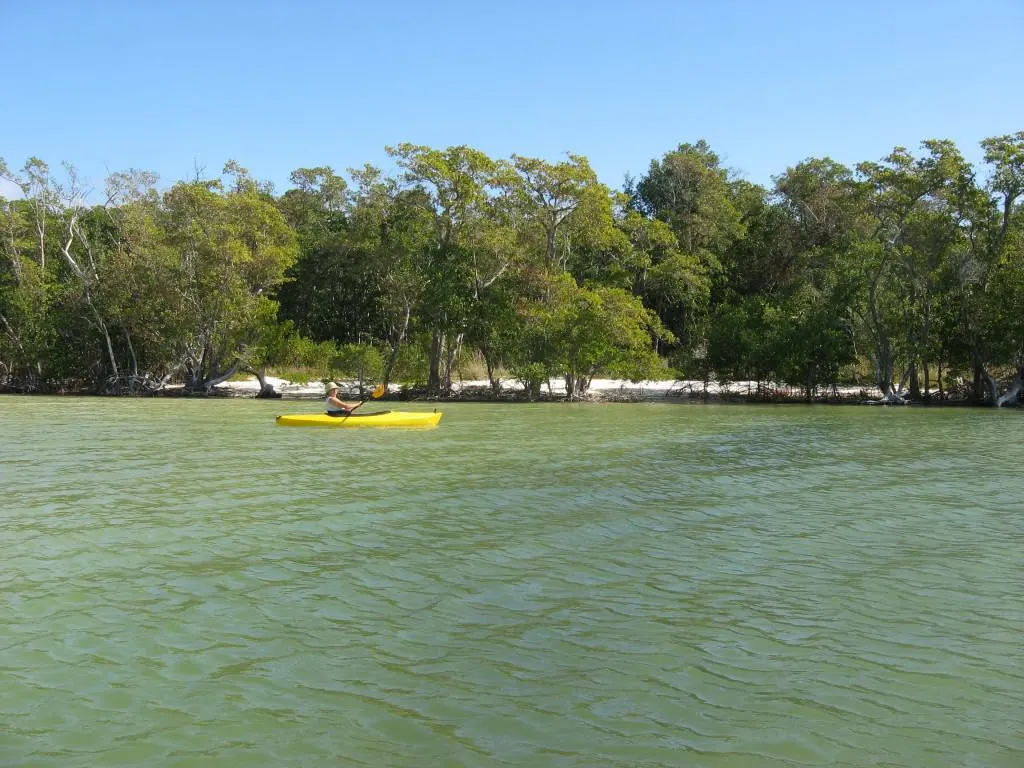
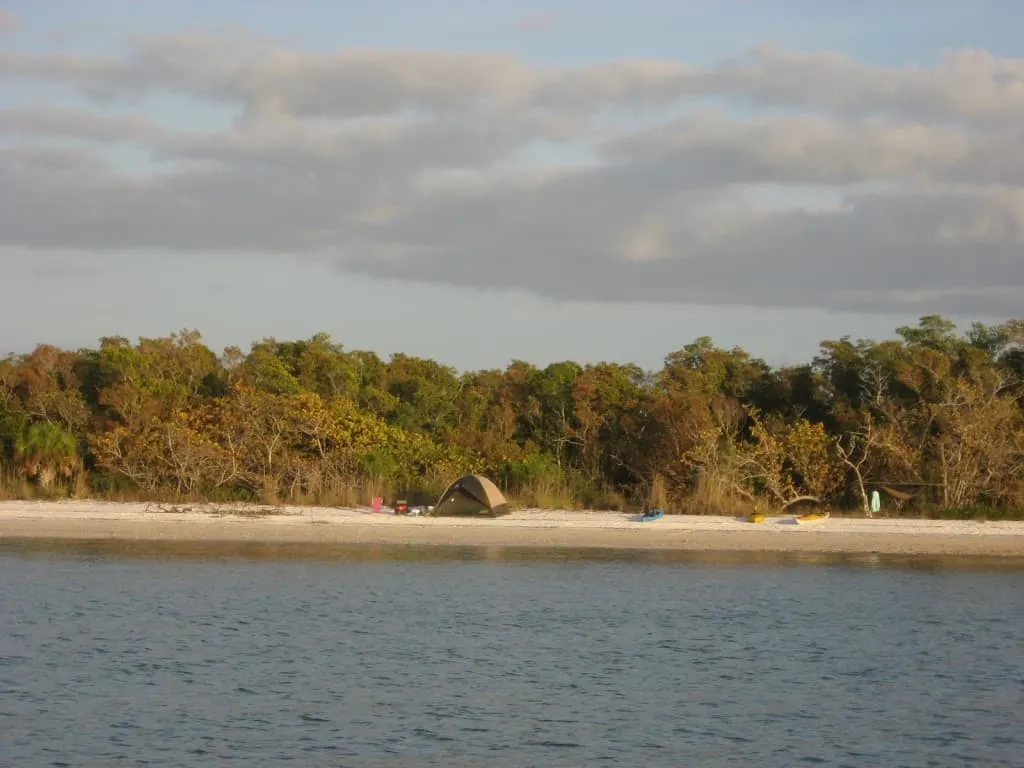
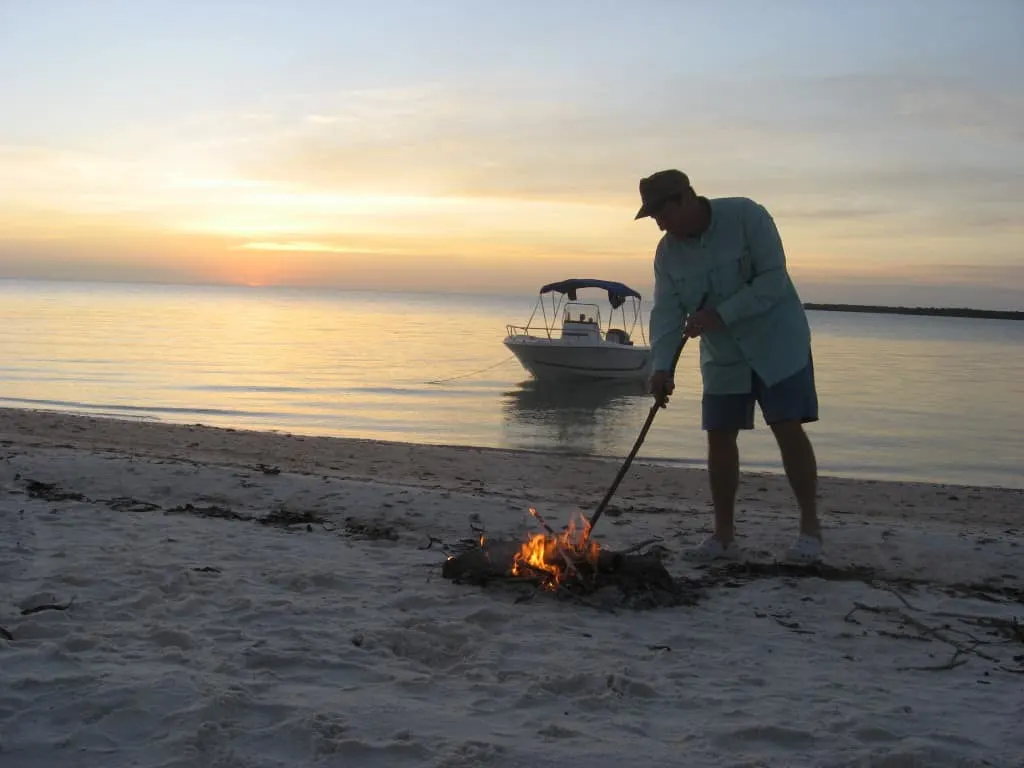
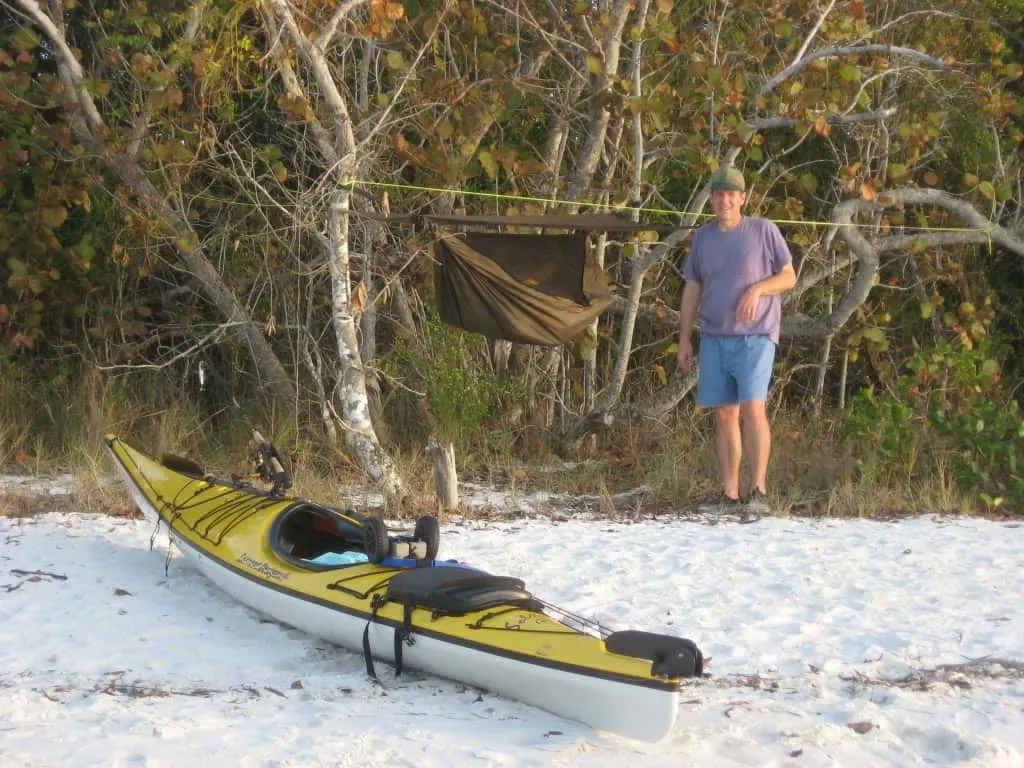
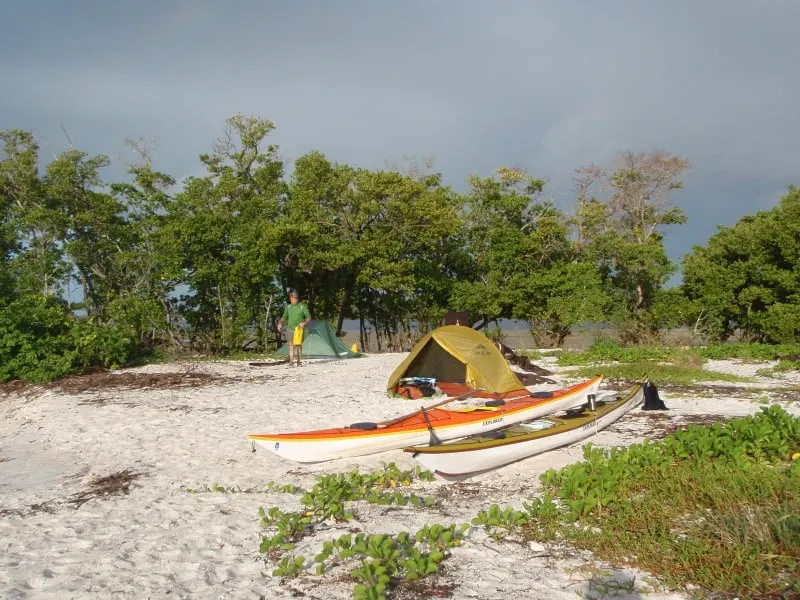
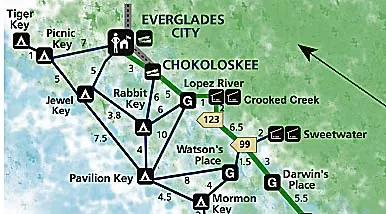
Nature-Lovers South Florida Road Trip: Where To Go And What To Do Red Around the World
Wednesday 13th of July 2022
[…] If you have a boat or are renting one and are feeling adventurous (and are comfortable with your boating/navigational skills) consider camping out on an island! […]